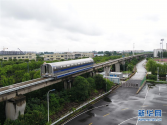The current goal is for the 1st regional high speed maglev in China to be completed sometime after 2026, and most likely extended to link the large delta regions of Shanghai, Guangzhou and Beijing afterwards. If this actually happens, I am curious what this will do to China's airline business, let alone the C919 and CR929. The C919 might just evolve into a mostly export item while the CR929 becomes China's mainline carrier.
Regional airlines are affected most, but C919 and C929 should be fine. C919 will still be the mainstay of Chinese domestic aviation, with far larger demand than C929, something like thousands vs. hundreds when all is said and done. C919 can provide the frequency and has range between 4,100km-5,600km to connect almost any two cities within China, as well as Chinese cities and neighboring countries. The primary markets for both C919 and C929 will still be domestic airlines, particularly the latter.
The Chinese aviation market is large and still growing, and there should be enough demands for both high-speed rail and air flights. They key is to design the integrated network and services among different modes of transport, providing convenience and comfort for passengers and travelers. The mentality needs to be changed from just building to increasingly servicing. These will further stimulate demands as the country becomes more affluent.

